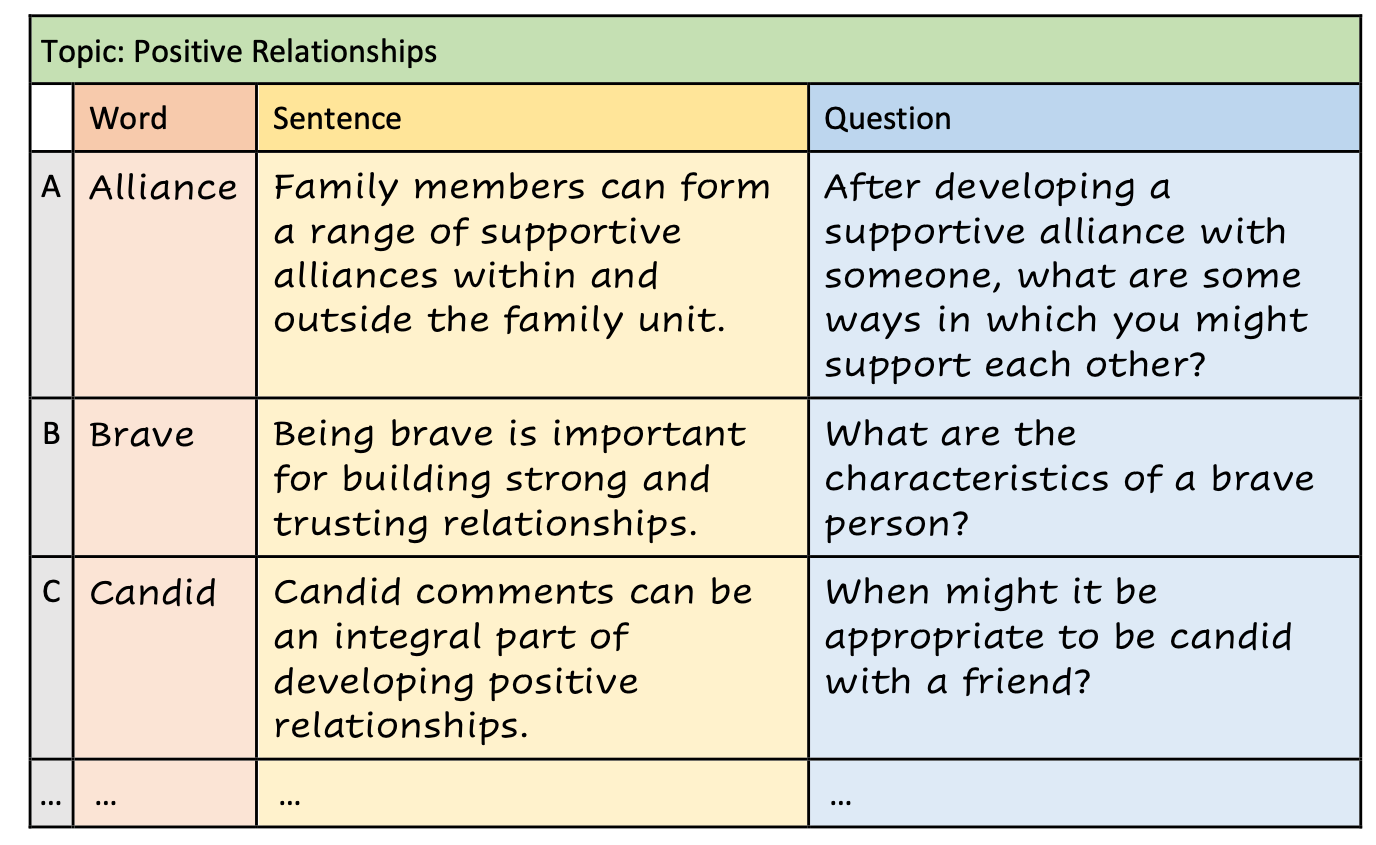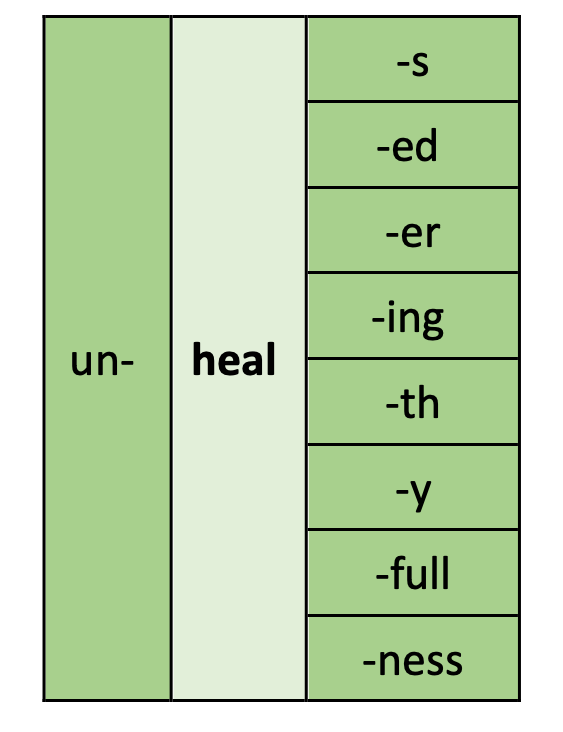Building vocabulary and terminology in Health and Physical Education (HPE) can be highly contextual. Health specific terminology is routinely used in real-world situations. Examples include
- visiting the doctor
- observing advertisements and social media relating to health promotion,
- learning about sports, drugs, alcohol, and road safety.
Beck, McKeown and Kucan (2013) categorise vocabulary into three tiers:
- Tier 1: everyday words (e.g. jump, fitness)
- Tier 2: words that are useful across multiple subject areas (e.g. agility, endurance)
- Tier 3: subject-specific words or technical terminology (e.g. motor skills, aerobic capacity).
Building knowledge of vocabulary items at Tier 2 and 3 words allows students to access and communicate HPE content knowledge.
Supplying word games and templates can help students in making the cognitive links between the vocabulary and their context within HPE. These approaches also create a specific framework and structure for students to express what they know.
Literacy in Practice Video: Physical Education - Building Vocabulary
Teacher: Chris Cafiso
Alphabet Key
Tony Ryan's 'Alphabet Key' (2014), one strategy in the
Thinker's Keys suite allows teachers to use a differentiated framework for students to communicate in writing their knowledge of a given topic.
Students must list all the letters of the alphabet down the left-hand side of the page. Using each letter, they then create their own word, sentence, or question that they link to the topic or passage being analysed.
To differentiate for various capability levels, teachers may choose for students to:
- write a single word for each letter
- provide quotas for the number of tiers 1, 2- and 3-words students can use
- write a full sentence
- construct a question.
In the example below, a teacher has used an alphabet key to support students' learning about positive relationships in Year 7 and 8 (VCHPEP127).

The teacher may also set specific criteria to guide the direction of the information being presented. For example:
- Five of the sentences must include statistics
- Sentences must include at least one adjective.
This strategy can be used for different purposes, including:
-
Tuning in to learning. Students brainstorm words on a given topic using the alphabet key.
-
During learning. Students process the information and articulate it through the alphabet key as a word, sentence, or question.
- Students may also work in pairs, to deepen their knowledge and understanding.
- This activity may also extend into verbal discussions with peers as well as justification for word choices
(HITS 5: collaborative learning). Example: "I used 'candid' for the letter C as I believe that having the ability to have a candid conversation is key to a positive relationship."
-
As an assessment task. For example, for a topic on Positive Relationships, students could be asked to construct an alphabet key that includes:
- at least 3 strategies for addressing peer pressure as a teenager
- at least 3 statistics or facts that relate to this topic
- keywords and language that illustrate what you have learnt during this unit
Multi-modal variations are also possible, and teachers could ask students to:
- choose to illustrate concepts/ideas for some of the letters by inserting symbols, diagram or emojis, using a tool such as
coolsymbol
- create a
wordcloud a
wordart
- use the questions created to make a quiz or class competition. Platforms for this may be Google Forms/quizzes,
kahoot or
peardeck.
Teaching base words and word parts (morphemes)
Morphemes are the smallest units of meaning represented in written and spoken language. There are several types of morphemes, including bases, roots, and affixes (i.e. prefixes and suffixes).
Words, for example, can be deconstructed into more than one morpheme, as in the word
player which consists of two morphemes: [play] + [-er] and the word
moving consists of [move] and [-ing]. Words can represent different meanings by attaching morphemes. For example, adding the prefix [re-] to 'play,' forms the word 'replay.' Also, adding grammatical suffixes such as [-ing] or [-ed] allow us to form the words
replayed and
replaying. Adding a nominalisation suffix like [-ment] to the word
move changes this verb into the noun
movement. Compound words can also be formed by joining two base morphemes together as we see in the words
playground and
outplay.
Rather than memorising words, students can learn about morphemes to look 'inside' unfamiliar technical terms to find the meaningful parts of words.
Understanding how morphemes work offers students transferable knowledge about the spelling of words and how spelling can represent not just sounds but meaning. The development of morphemic awareness can directly support vocabulary development with the potential to improve writing and reading comprehension (Herrington & Macken-Horarik, 2015; Nunes & Bryant, 2006).
One way to teach morphemes is to use morphological matrices, like the one below adapted from the work of Bowers and Kirby (2010) and Kirby and Bowers (2017). The matrix below is for the base word, 'heal,' and was used in a Year 7 and 8 class (VCHPEP126).
In the central column, the base word is listed. In the column to the left of the base word, prefixes are listed. In the column to the right of the base word, suffixes are listed. Students can then use the morphological matrix to generate word sums (see below).

heal
heal + s = heals
heal + ed = healed
heal + er = healer
heal + ing = healing
heal + th = health
heal + th + y = healthy
heal + th + y + er = healthier [spelling rule: change the y to an i before adding -er]
heal + th + full = healthful [spelling rule: when FULL is added to the end of a word use one L]
heal + th + y + ness = healthiness
heal + th + full + ness = healthfulness [spelling rule: when FULL is sitting inside a word, use one L]
un + heal + th + y = unhealthy
un + heal + th + y + er = unhealthier
Another tool to teach morphemes is the use of Stant's part card. Teachers can also review the use of
Stants's part card in Science to consider how it might be applied to learning new terminology in HPE.
Explicitly teaching terminology in sport
To create a shared understanding of a sport, its rules, and ways to play, teachers need to support students to develop appropriate vocabulary and language to use when playing and speaking about, a sport.
While sport has the potential to promote inclusivity, challenge racism and support gender and cultural diversity (Cortis et al., 2007; Foley, Taylor & Maxwell, 2011; Olliff, 2008), not all students have the cultural knowledge to take part fully in all sports. To promote inclusivity and engagement with all students, teachers should first show a shared understanding of the language and terms used within a sport.
To do this, when introducing a sport, teachers can:
- explicitly teach new terminology for equipment
- For example: Are the hitting implements for a ball sport referred to as a racquet, stick or bat? Is the item that is hit referred to as a ball, puck, or shuttle?
- use roleplay to demonstrate and explain rules
- For example, use three students to demonstrate what 'off-side' means in soccer or rugby; or use a group of students to demonstrate 'zone defence'; use two pairs of students to demonstrate 'man-to-man' defence.
- remind students of the terminology used within a game to call a play or encourage teammates
- For example, the teacher might halt gameplay to remind students of the play or call they should be using, such as 'huddle,' 'tag,' 'go wide,' 'man-up.'
Similarly, for fitness plans, teachers should explicitly teach new terminology and common abbreviations, such as:
- rep (repetition) and set
- HR (heart rate) and bpm (beats per minute) compared to BR (breathing rate) and bpm (breaths per minute)
- ROM (range of motion).
This might be achieved through
joint construction of definitions or the use of illustrative glossaries (see strategies in
Geography and
Visual Arts).
Curriculum links for the above examples:
VCHPEM135,
VCHPEM136,
VCHPEM153,
VCHPEM155.